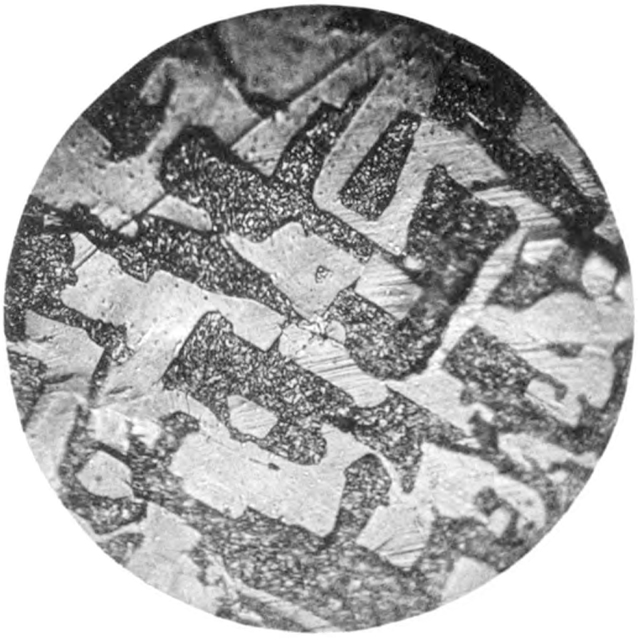a consequence of straining

Plate 28, Fig. 49
Slowly-cooled lead-bismuth eutectic, etched and strained, showing slip-bands. 1000 diameters, vertical light.
illustrating J(ames) A(lfred) Ewing (1855-1935 *) and Walter Rosenhain (1875-1934 *). “The Crystalline Structure of Metals.” Philosophical Transactions (of the Royal Society of London), Series A Containing papers of a mathematical or physical character (1900) : 353-375
“By adopting the device of slow cooling, which has led to such excellent results in the hands of Messrs. Heycock and Neville, we have succeeded in producing specimens of eutectics in which the characteristic structure is developed on a much larger scale. Fig. 49 exemplifies this in the eutectic of bismuth and lead, and shows slips which occur in the white constituent as a consequence of straining. This photograph illustrates a feature very characteristic of eutectic alloys; a parallel system of slip-bands extends over many patches of the white constituent, thus pointing to the fact that the crystalline elements are similarly oriented throughout considerable areas of at least one of the two constituents of the alloy.”
(pp 371)
The paper concludes thus ‐
“Reviewing the general results of the experiments, we consider that they establish the view that the structure of metals in general is crystalline, and remains crystalline when the form of the metal is altered by strain, plastic yielding being due to slips on cleavage or gliding planes within each individual crystalline grain, and partly (in some metals) to the production of twin crystals.”
—
Why? I’m interested in the aesthetic dimension of non-aesthetic images — located I think in that moment, in the course of technical and craft work, preparation of specimens, analytical investigation, theoretical reflection, etc. — where one decides to “click,” to take the evidence.
And Ewing and Rosenhain are both fascinating. Dundee-born Ewing participated in cable laying expeditions, taught mechanical engineering at Tokyo Imperial University (1878-83), was importantly involved in seismology and the development of the steam turbine (in addition to his metallurgical work). Later in his life he managed “Room 40” (the Admiralty unit responsible for cryptanalysis). Rosenhain — born in Germany, raised in Australia, active in England — was a brilliant metallurgist and manager of an important metallurgical laboratory; a productive and clear writer, he also worked on optical glass.
Obituary notices can be found at jstor for Ewing (Royal Society), and the Australian Dictionary of Biography for Rosenhain. Or see their respective wikipedia pages, linked above.
tags:
aesthetics of technical images; lead-bismuth eutectic; metallurgy; rounds
J. A. Ewing; Walter Rosenhain